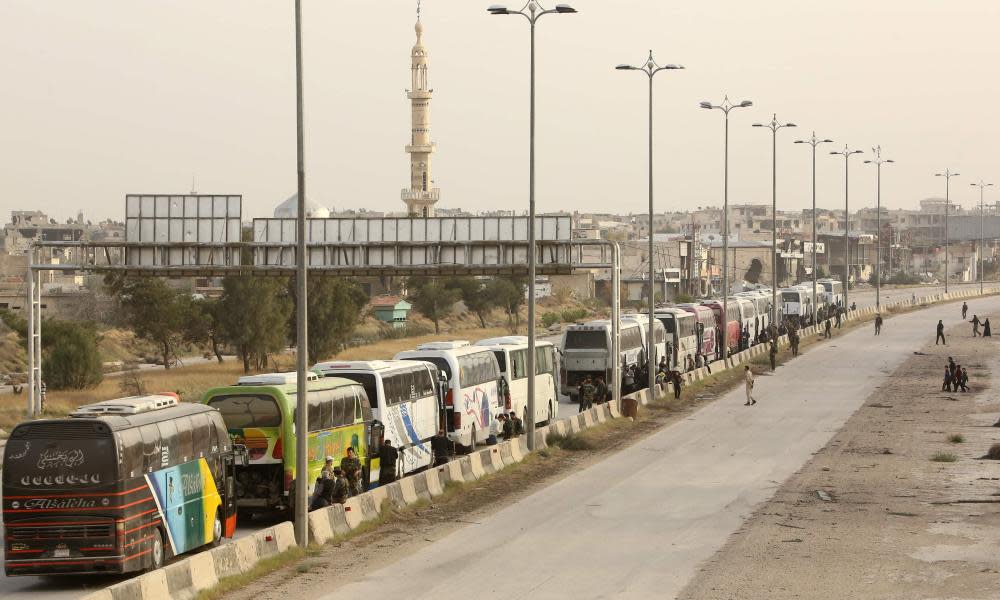Syrian rebels and families begin exile from besieged Ghouta

Around 200 opposition fighters and family members have left the besieged enclave of Ghouta after agreeing with Russian and Syrian officials to be exiled to Idlib, in northern Syria.
Up to 7,500 fighters and their families will be deported as part of the deal, which followed assurances from Russian military officers that other civilians in the Harasta neighbourhood could remain in their homes.
The forced transfer follows the relentless month-long bombardment of Ghouta, on the outskirts of the Syrian capital, Damascus. Thousands of refugees have fled the enclave over the past week.
Those being exiled on Thursday were rebels from the Ahrar al-Sham faction, which was dominant in Harasta over the last few years of the siege. Ghouta has been an opposition stronghold throughout much of the war, but large parts of it have now been recaptured by the regime.
At least 1,500 people, most of them civilians, were killed in the airstrikes, which aid agencies described as a systematic annihilation.
The transfer is the latest of many similar deals made elsewhere in Syria. All have followed intensive blockades and military attacks, and have led to those leaving being bussed to Idlib.
All of Idlib province remains out of central government control. Along with an estimated 1.6 million local residents, at least another 1 million displaced people from elsewhere in Syria have ended up in the province. It is the one part of the country that largely confirms the regime narrative that the forces confronting it are dominated by jihadists.
(March 1, 2011)
Unprecedented protests demand civil liberties and the release of political prisoners after four decades of repressive rule by the Assad family. The regime represses demonstrations in Damascus and the southern city of Deraa but protests continue.
(July 1, 2011)
Defecting army colonel Riad al-Asaad sets up the Turkey-based rebel Free Syrian Army. Islamist groups join the revolt.
(March 1, 2012)
Regime forces take control of the rebel stronghold in Homs after a month of bombardment. Other bloody operations are carried out, notably in the central city of Hama, after massive anti-regime protests.
(July 1, 2012)
FSA fighters launch a battle for Damascus but the government holds firm.
(August 1, 2013)
More than 1,400 people die in a chemical weapon attack on rebel-held districts near Damascus.
(September 1, 2013)
The US and Assad ally Russia agree a plan to eliminate Syria's chemical weapons, averting punitive US strikes against the regime.
(January 1, 2014)
Hostilities between jihadists and rebel groups turn into an open war in the north. The group that will become known as Islamic State takes Raqqa – the first provincial capital to fall out of regime control – from rebel forces.
(September 1, 2014)
A US-led coalition launches airstrikes against Isis in Syria. The strikes benefit Kurdish groups, which since 2013 have run autonomous administrations in Kurdish-majority areas.
(September 1, 2015)
Russia launches airstrikes in support of Assad's troops, who are on the back foot. Russian firepower helps turn the tables for the regime, which begins to retake rebel-held territory.
(December 1, 2016)
The regime retakes Syria's second city, Aleppo.
(January 1, 2017)
Russia and Iran, as backers of the Syrian regime, and Turkey, a supporter of the rebels, organise talks in Kazakhstan, between representatives of both sides. The process leads to the creation of four "de-escalation zones".
(April 1, 2017)
A sarin gas attack on the rebel-held town of Khan Sheikhun kills more than 80 people, prompting Washington to attack a regime airbase.
(January 1, 2018)
Further complicating an already drawn-out conflict, Turkey launches an operation against the Kurdish People's Protection Units which, with US support, played a key role in beating back Isis.
(February 1, 2018)
Regime launches a ferocious assault on the remaining rebel-held enclave near Damascus, eastern Ghouta. In under four weeks, the Russian-backed onslaught kills more than 1,200 civilians.
Extremist groups have held aegis in large parts of Idlib since 2013. And although Islamist and moderate groups have recently taken on the jihadists, ousting them from a swathe of territory, they retain influence over the way much of the region is governed.
Mixing jihadists with rebel groups and civilians from elsewhere in Syria is seen by many opposition leaders – and deportees themselves – as a ploy to reaffirm the regime claims that the insurrection it faced was a foreign-backed plot using jihadist proxies.
The danger, according to officials in neighbouring states, is that a war-weary international community will not be willing to draw a distinction, if and when the Syrian regime and its allies turn their guns on Idlib.
Senior Arab officials in Amman, Jordan, and Beirut, Lebanon, have described conditions in Idlib as a “well-constructed killbox”, where civilians will enjoy few protections in what could be the last and most decisive phase of the war, which entered an eighth year nearly two weeks ago.
What to do with the estimated 250,000 people who remain in Ghouta is yet to be determined. UN officials envisage that armed opposition groups and their families from two other areas inside the enclave will also be forced to leave in the coming weeks.
At least 50,000 civilians have left Ghouta for elsewhere in Damascus since the siege started to wind down a week ago. The bombings have not stopped, however, with dozens of people since killed. Much-needed aid has been allowed into Ghouta in the past week.

 Yahoo News
Yahoo News 
